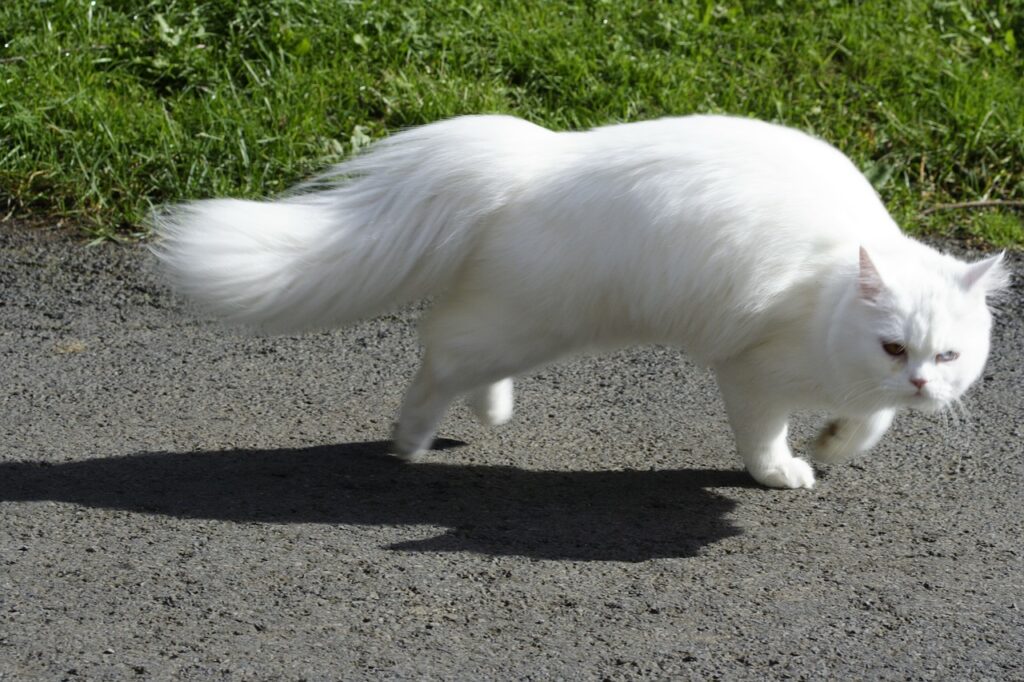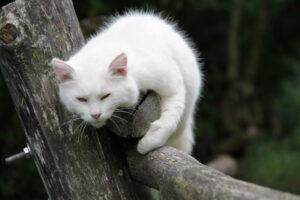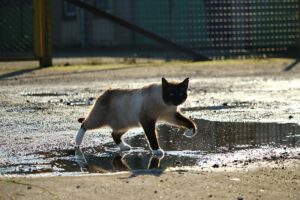How Fast Can A Cat Run ?

How Fast Can A Cat Run :- Cats exhibit remarkable agility, whether engaged in a pursuit or executing midnight sprints through your bedroom. Despite the perception of felines as creatures inclined towards leisurely lounging, they possess exceptional sprinting capabilities when the mood strikes. Observing Fluffy dashing across your yard might trigger curiosity about the true velocity of your cat’s full-speed run.
While renowned big cats like cheetahs are famed for reaching 75 miles per hour in pursuit of prey, domestic cats showcase impressive speed as well. The maximum running speed for a house cat is approximately 30 miles per hour (48 kilometers per hour). To put this in perspective, it surpasses the pace of Usain Bolt by 2 to 3 miles per hour! It’s worth noting that a cat’s running speed can be influenced by factors such as age, size, and breed. The 30 miles per hour benchmark represents the peak speed achievable by a cat in prime condition, whereas the average cat typically maintains a pace between 20 and 25 miles per hour.

Why Are Cats Able to Run Fast?
How Fast Can A Cat Run ? Cats inherently possess the instincts of skilled hunters, a trait that persists even in domestic settings where their every need is provided by their owners. Despite the comforts of home, the wild essence within them endures, particularly the instinct to chase after prey.
The propensity of cats to sleep extensively serves a purpose deeply rooted in their nature. By conserving energy through extended periods of rest, they maintain the capacity for swift sprints if the need to pursue prey arises. While house cats no longer rely on hunting for sustenance, the ingrained sleep-sprint pattern remains an integral part of their psyche, a testament to the enduring influence of their wild ancestry.
Can Cats Run Faster Than Dogs?
How Fast Can A Cat Run ? Cats, surprisingly, outrun many dogs in terms of speed. While canine speeds vary significantly based on breed, generally falling between 15 and 25 miles per hour, certain breeds like the German Shepherd, Border Collie, and Doberman Pinscher can reach up to 30 miles per hour. The Greyhound, renowned for its swiftness, boasts an impressive top speed of 40 miles per hour.
However, the remarkable aspect lies in the comparison of cat speed to their canine counterparts. Despite having significantly shorter legs than a German Shepherd, a cat’s speed is truly noteworthy. Imagining a race between the two might well require a photo finish.
While domestic cats might not challenge a cheetah in a sprint, they can certainly hold their ground when measured against other sizable cat species. For instance, the bobcat matches the domestic cat’s speed at 30 miles per hour. Surprisingly, your cozy companion may even outpace a sand cat, known for its average speed of around 25 miles per hour.

How Fast Can A Cat Run ? HUMANS VS. CATS IN RUNNING SKILLS
How Fast Can A Cat Run? It’s truly astonishing to consider that your gentle, purring cat, devoid of any warm-up routine, could effortlessly outpace the fastest human runners. The pinnacle of human speed stands at approximately 27 mph, a record achieved only by a select few athletes with exceptional talent, rigorous training, and peak physical condition. Even the average athlete might reach speeds up to 22 mph, but for us mere mortals, the prospect of outrunning an elephant, which moves at a steady 10 – 15 mph, seems like an insurmountable challenge.
Now, enter your ordinary, healthy housecat, untouched by training, conditioning, stretching, or carbohydrate loading, yet capable of a remarkable speed of about 30 mph. This incredible athleticism can be unleashed with just a touch of motivation, whether it be the pursuit of fleeing prey or escaping a larger canine adversary.

Admittedly, some might argue that comparing a cat’s four legs to a human’s two is not entirely equitable, given our longer limbs. However, an assistant professor at Rice University, highlights in the Forbes article, “What’s the Human Speed Limit?”, both species utilize the same running materials—bones, muscles, and tendons. Surprisingly, it’s not the number of legs or the speed of leg movement that dictates the difference in speed, but rather the amount of muscle force the legs can exert on the ground. Cats, with their robust leg muscles and extraordinarily flexible spines that arch and straighten as they run, boast an impressive biomechanical advantage, contributing to their substantial stride and remarkable speed.
How Fast Can A Cat Run ? How High or Far Can Cats Jump?
The everyday housecat showcases an extraordinary ability to leap, effortlessly clearing distances that are 5 to 6 times their own height. Frequently vaulting vertically to heights ranging from 6-8 feet, cats achieve these impressive jumps without the benefit of a running start. Witnessing a cat effortlessly spring from the floor to the top of the refrigerator or gracefully sail over a backyard privacy fence highlights the remarkable power of their hind leg muscles.
If humans possessed the jumping prowess of a cat, leaping 5-6 times their own height, they could achieve heights of 20 to 30 feet. In this comparison, it’s clear that the feline reigns supreme in the realm of vertical agility. Once again, the kitty emerges as the undeniable champion in the arena of extraordinary physical feats.
Are some cat breeds faster than others?
How Fast Can A Cat Run ? Factors such as size, age, and health significantly influence your cat’s running capabilities. Surprisingly, breed also plays a role in determining their speed during sprints. The title of the fastest domestic cat breed goes to the Egyptian Mau, boasting an impressive running speed clocked at 30 miles per hour. This breed is renowned for its robust hind legs, facilitating agile movements, even enabling them to ascend trees with ease.

Certain cat breeds are inherently built for speed. Abyssinians, with their long legs and sleek frames, are both lightweight and aerodynamic, contributing to their swift running abilities. Savannah cats, closely linked to wild Servals, also exhibit remarkable sprinting prowess. Other swift feline breeds include Orientals, Bengals, Siamese, Somalis, and Manx.
Conversely, shorter and stockier breeds tend to be slower runners. Examples include American Shorthairs, Ragdolls, and Maine Coons. Cats with hereditary health issues, such as brachycephalic breeds like Persians and Himalayans, might also experience limitations in running speed due to breathing difficulties.
When it comes to wild cats, cheetahs are renowned as the fastest mammals globally. However, the lesser-known Jaguarundi claims the second spot among large felines. Indigenous to Southern and Central America, Jaguarundis showcase an impressive running speed of 60 miles per hour (96 kilometers per hour). This places them ahead of African lions, Servals, and mountain lions, which typically run at around 50 miles per hour (80 kilometers per hour). The world of feline athleticism holds surprises beyond the well-known speedsters.
What Makes Cats So Fast?
1. Muscular Legs:
Some may argue that the advantage of cats in terms of speed is attributed to their double set of legs compared to humans. However, the crucial factor here is not the quantity but the quality of these legs. Your cat’s back legs are powerhouses of muscle, providing the strength needed to propel them forward with each stride.
2. Flexible Spine:
The feline spine is a marvel in contributing to their speed. Exceptionally flexible, it functions like a spring, compressing and expanding to launch the cat forward. This flexibility also grants cats a longer stride, allowing them to cover significant distances in a single bound.

3. Body Shape:
Most cats boast a lithe and slim physique, a design that enhances their aerodynamics. This sleek body shape minimizes air resistance when they run, resulting in less drag compared to wider, bulkier animals.
4. Running on Their Toes:
Cats exhibit a digitigrade walking style, meaning they walk on their toes rather than the soles of their feet, as humans do. If you observe your cat’s paws during a stroll, you’ll notice the backs of their feet are slightly lifted off the ground. This unique walking style allows them to move swiftly and with heightened agility.




